Exploring UK Health and Social Care: Origins, Collaboration, and Needs
VerifiedAdded on 2023/06/10
|12
|2431
|117
Report
AI Summary
This report provides a comprehensive overview of the health and social care sector in the UK, exploring its historical origins and evolution, particularly in relation to the third sector. It highlights the importance of understanding this context for fostering effective working relationships among professionals. The report also delves into the primary health and social care needs of individuals in middle-aged adulthood, including chronic diseases, mental health challenges, and social isolation. Furthermore, it examines the concept of vulnerability, particularly among adolescents, and the associated risk factors, drawing upon theoretical frameworks such as Maslow's hierarchy of needs, Erikson's psychosocial development theory, and Bandura's social learning theory. The document emphasizes the role of health and social care practitioners in addressing these vulnerabilities and promoting positive health outcomes. Desklib offers a range of resources, including past papers and solved assignments, for students studying in this field.
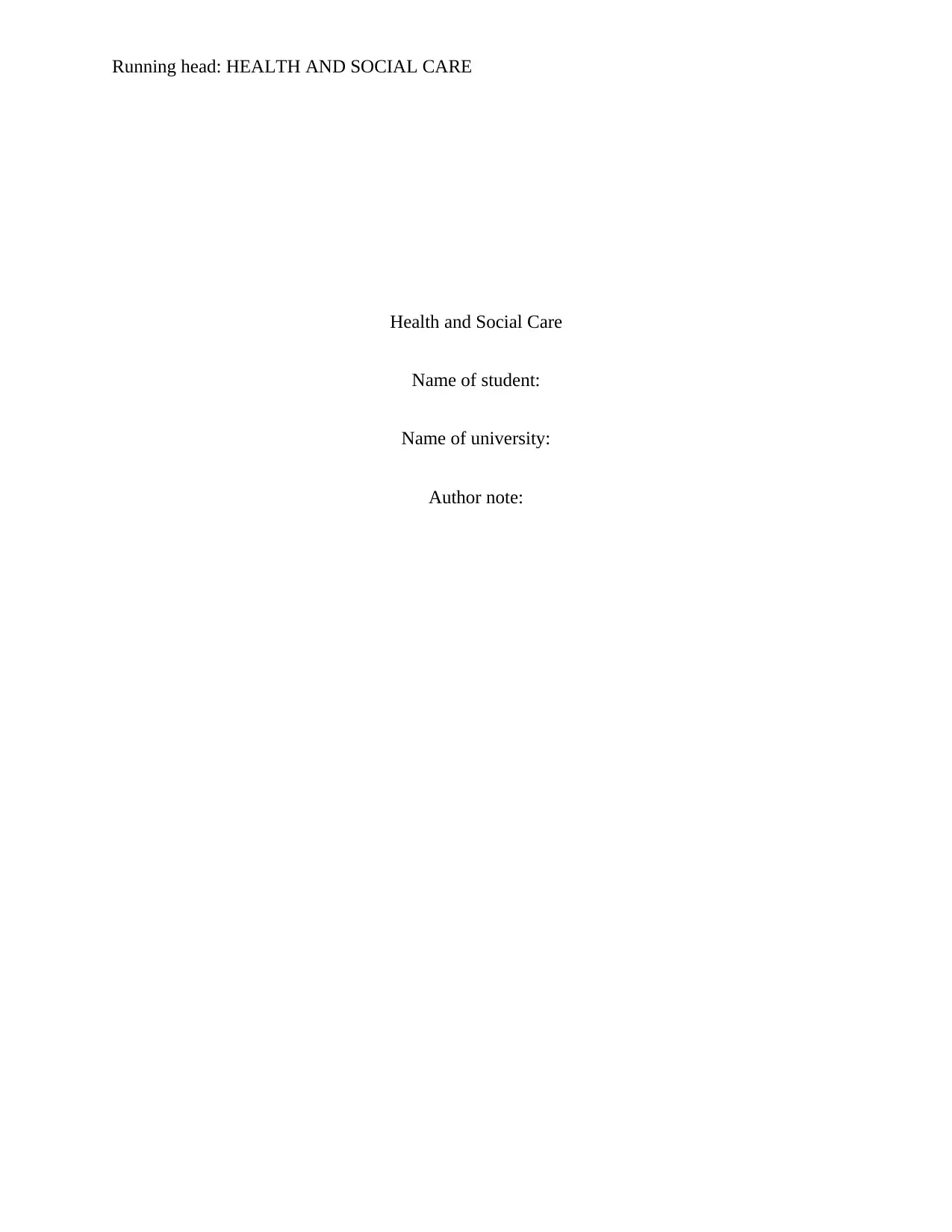
Running head: HEALTH AND SOCIAL CARE
Health and Social Care
Name of student:
Name of university:
Author note:
Health and Social Care
Name of student:
Name of university:
Author note:
Paraphrase This Document
Need a fresh take? Get an instant paraphrase of this document with our AI Paraphraser
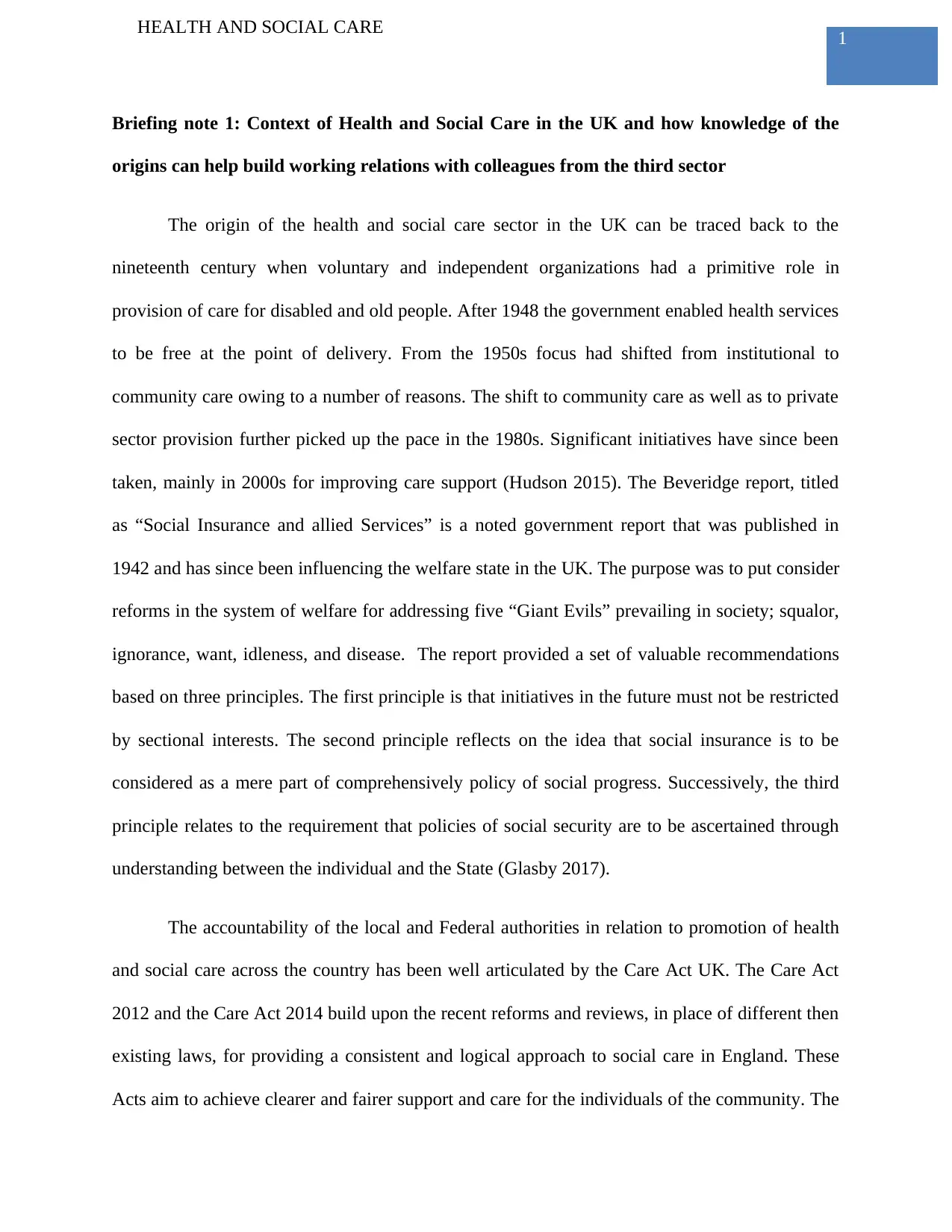
1
HEALTH AND SOCIAL CARE
Briefing note 1: Context of Health and Social Care in the UK and how knowledge of the
origins can help build working relations with colleagues from the third sector
The origin of the health and social care sector in the UK can be traced back to the
nineteenth century when voluntary and independent organizations had a primitive role in
provision of care for disabled and old people. After 1948 the government enabled health services
to be free at the point of delivery. From the 1950s focus had shifted from institutional to
community care owing to a number of reasons. The shift to community care as well as to private
sector provision further picked up the pace in the 1980s. Significant initiatives have since been
taken, mainly in 2000s for improving care support (Hudson 2015). The Beveridge report, titled
as “Social Insurance and allied Services” is a noted government report that was published in
1942 and has since been influencing the welfare state in the UK. The purpose was to put consider
reforms in the system of welfare for addressing five “Giant Evils” prevailing in society; squalor,
ignorance, want, idleness, and disease. The report provided a set of valuable recommendations
based on three principles. The first principle is that initiatives in the future must not be restricted
by sectional interests. The second principle reflects on the idea that social insurance is to be
considered as a mere part of comprehensively policy of social progress. Successively, the third
principle relates to the requirement that policies of social security are to be ascertained through
understanding between the individual and the State (Glasby 2017).
The accountability of the local and Federal authorities in relation to promotion of health
and social care across the country has been well articulated by the Care Act UK. The Care Act
2012 and the Care Act 2014 build upon the recent reforms and reviews, in place of different then
existing laws, for providing a consistent and logical approach to social care in England. These
Acts aim to achieve clearer and fairer support and care for the individuals of the community. The
HEALTH AND SOCIAL CARE
Briefing note 1: Context of Health and Social Care in the UK and how knowledge of the
origins can help build working relations with colleagues from the third sector
The origin of the health and social care sector in the UK can be traced back to the
nineteenth century when voluntary and independent organizations had a primitive role in
provision of care for disabled and old people. After 1948 the government enabled health services
to be free at the point of delivery. From the 1950s focus had shifted from institutional to
community care owing to a number of reasons. The shift to community care as well as to private
sector provision further picked up the pace in the 1980s. Significant initiatives have since been
taken, mainly in 2000s for improving care support (Hudson 2015). The Beveridge report, titled
as “Social Insurance and allied Services” is a noted government report that was published in
1942 and has since been influencing the welfare state in the UK. The purpose was to put consider
reforms in the system of welfare for addressing five “Giant Evils” prevailing in society; squalor,
ignorance, want, idleness, and disease. The report provided a set of valuable recommendations
based on three principles. The first principle is that initiatives in the future must not be restricted
by sectional interests. The second principle reflects on the idea that social insurance is to be
considered as a mere part of comprehensively policy of social progress. Successively, the third
principle relates to the requirement that policies of social security are to be ascertained through
understanding between the individual and the State (Glasby 2017).
The accountability of the local and Federal authorities in relation to promotion of health
and social care across the country has been well articulated by the Care Act UK. The Care Act
2012 and the Care Act 2014 build upon the recent reforms and reviews, in place of different then
existing laws, for providing a consistent and logical approach to social care in England. These
Acts aim to achieve clearer and fairer support and care for the individuals of the community. The
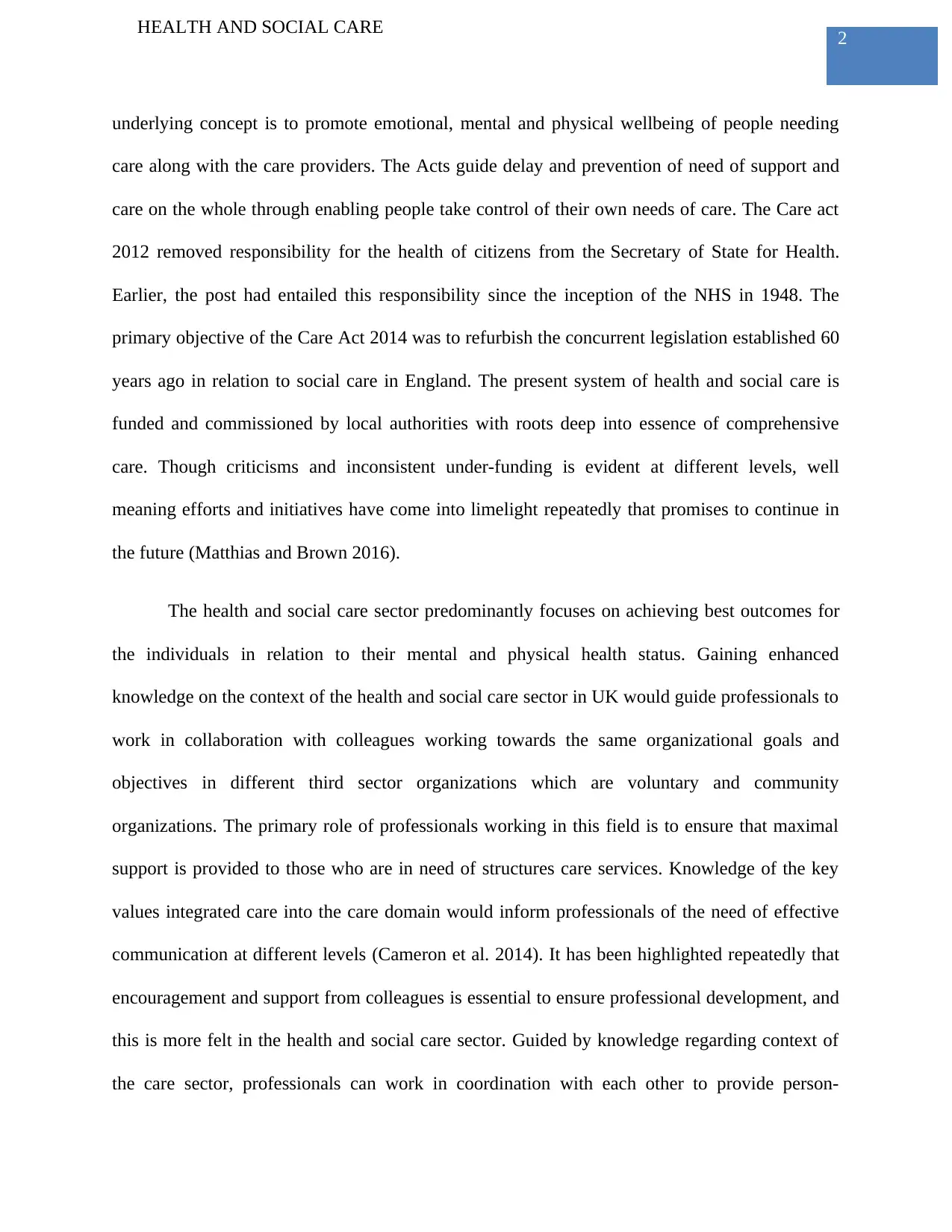
2
HEALTH AND SOCIAL CARE
underlying concept is to promote emotional, mental and physical wellbeing of people needing
care along with the care providers. The Acts guide delay and prevention of need of support and
care on the whole through enabling people take control of their own needs of care. The Care act
2012 removed responsibility for the health of citizens from the Secretary of State for Health.
Earlier, the post had entailed this responsibility since the inception of the NHS in 1948. The
primary objective of the Care Act 2014 was to refurbish the concurrent legislation established 60
years ago in relation to social care in England. The present system of health and social care is
funded and commissioned by local authorities with roots deep into essence of comprehensive
care. Though criticisms and inconsistent under-funding is evident at different levels, well
meaning efforts and initiatives have come into limelight repeatedly that promises to continue in
the future (Matthias and Brown 2016).
The health and social care sector predominantly focuses on achieving best outcomes for
the individuals in relation to their mental and physical health status. Gaining enhanced
knowledge on the context of the health and social care sector in UK would guide professionals to
work in collaboration with colleagues working towards the same organizational goals and
objectives in different third sector organizations which are voluntary and community
organizations. The primary role of professionals working in this field is to ensure that maximal
support is provided to those who are in need of structures care services. Knowledge of the key
values integrated care into the care domain would inform professionals of the need of effective
communication at different levels (Cameron et al. 2014). It has been highlighted repeatedly that
encouragement and support from colleagues is essential to ensure professional development, and
this is more felt in the health and social care sector. Guided by knowledge regarding context of
the care sector, professionals can work in coordination with each other to provide person-
HEALTH AND SOCIAL CARE
underlying concept is to promote emotional, mental and physical wellbeing of people needing
care along with the care providers. The Acts guide delay and prevention of need of support and
care on the whole through enabling people take control of their own needs of care. The Care act
2012 removed responsibility for the health of citizens from the Secretary of State for Health.
Earlier, the post had entailed this responsibility since the inception of the NHS in 1948. The
primary objective of the Care Act 2014 was to refurbish the concurrent legislation established 60
years ago in relation to social care in England. The present system of health and social care is
funded and commissioned by local authorities with roots deep into essence of comprehensive
care. Though criticisms and inconsistent under-funding is evident at different levels, well
meaning efforts and initiatives have come into limelight repeatedly that promises to continue in
the future (Matthias and Brown 2016).
The health and social care sector predominantly focuses on achieving best outcomes for
the individuals in relation to their mental and physical health status. Gaining enhanced
knowledge on the context of the health and social care sector in UK would guide professionals to
work in collaboration with colleagues working towards the same organizational goals and
objectives in different third sector organizations which are voluntary and community
organizations. The primary role of professionals working in this field is to ensure that maximal
support is provided to those who are in need of structures care services. Knowledge of the key
values integrated care into the care domain would inform professionals of the need of effective
communication at different levels (Cameron et al. 2014). It has been highlighted repeatedly that
encouragement and support from colleagues is essential to ensure professional development, and
this is more felt in the health and social care sector. Guided by knowledge regarding context of
the care sector, professionals can work in coordination with each other to provide person-
⊘ This is a preview!⊘
Do you want full access?
Subscribe today to unlock all pages.

Trusted by 1+ million students worldwide
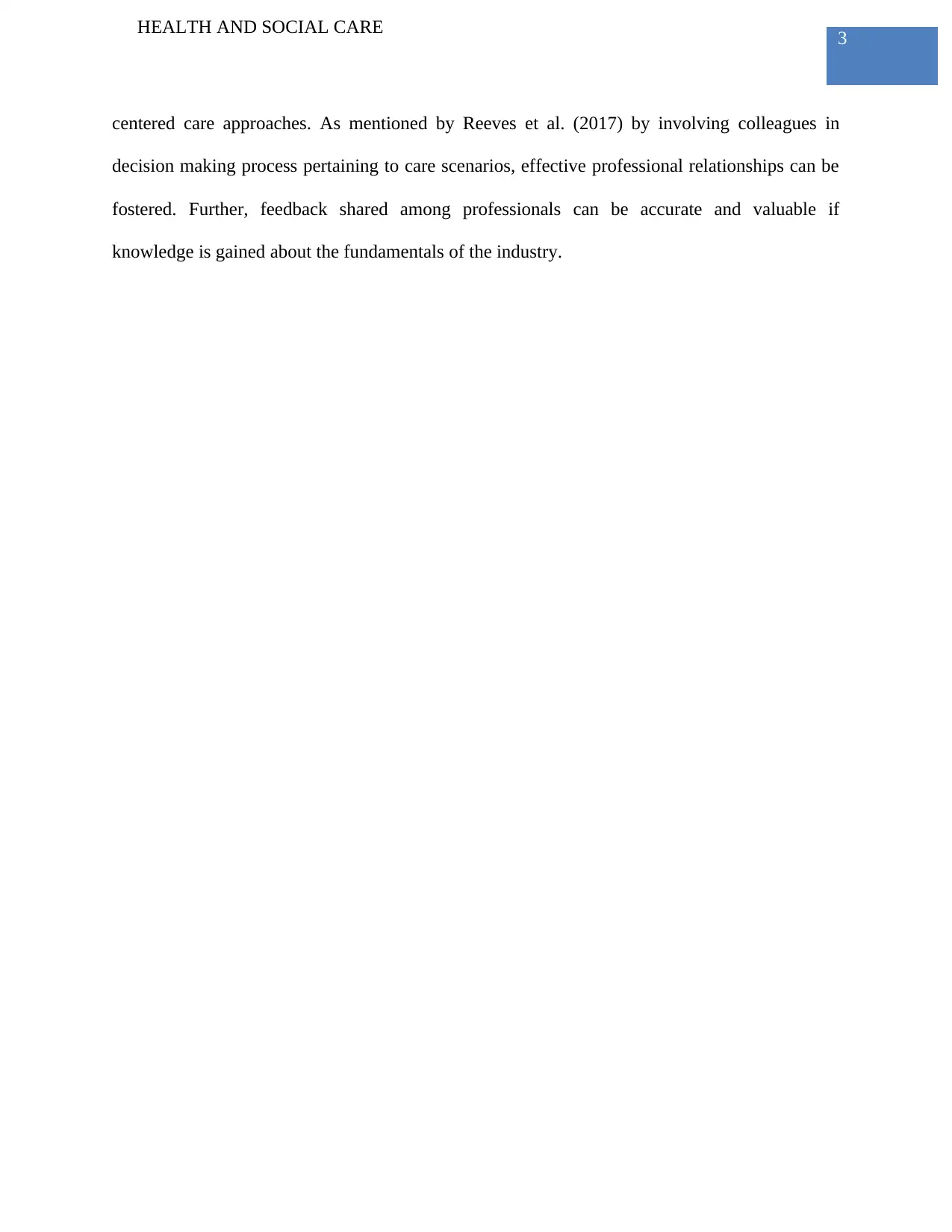
3
HEALTH AND SOCIAL CARE
centered care approaches. As mentioned by Reeves et al. (2017) by involving colleagues in
decision making process pertaining to care scenarios, effective professional relationships can be
fostered. Further, feedback shared among professionals can be accurate and valuable if
knowledge is gained about the fundamentals of the industry.
HEALTH AND SOCIAL CARE
centered care approaches. As mentioned by Reeves et al. (2017) by involving colleagues in
decision making process pertaining to care scenarios, effective professional relationships can be
fostered. Further, feedback shared among professionals can be accurate and valuable if
knowledge is gained about the fundamentals of the industry.
Paraphrase This Document
Need a fresh take? Get an instant paraphrase of this document with our AI Paraphraser
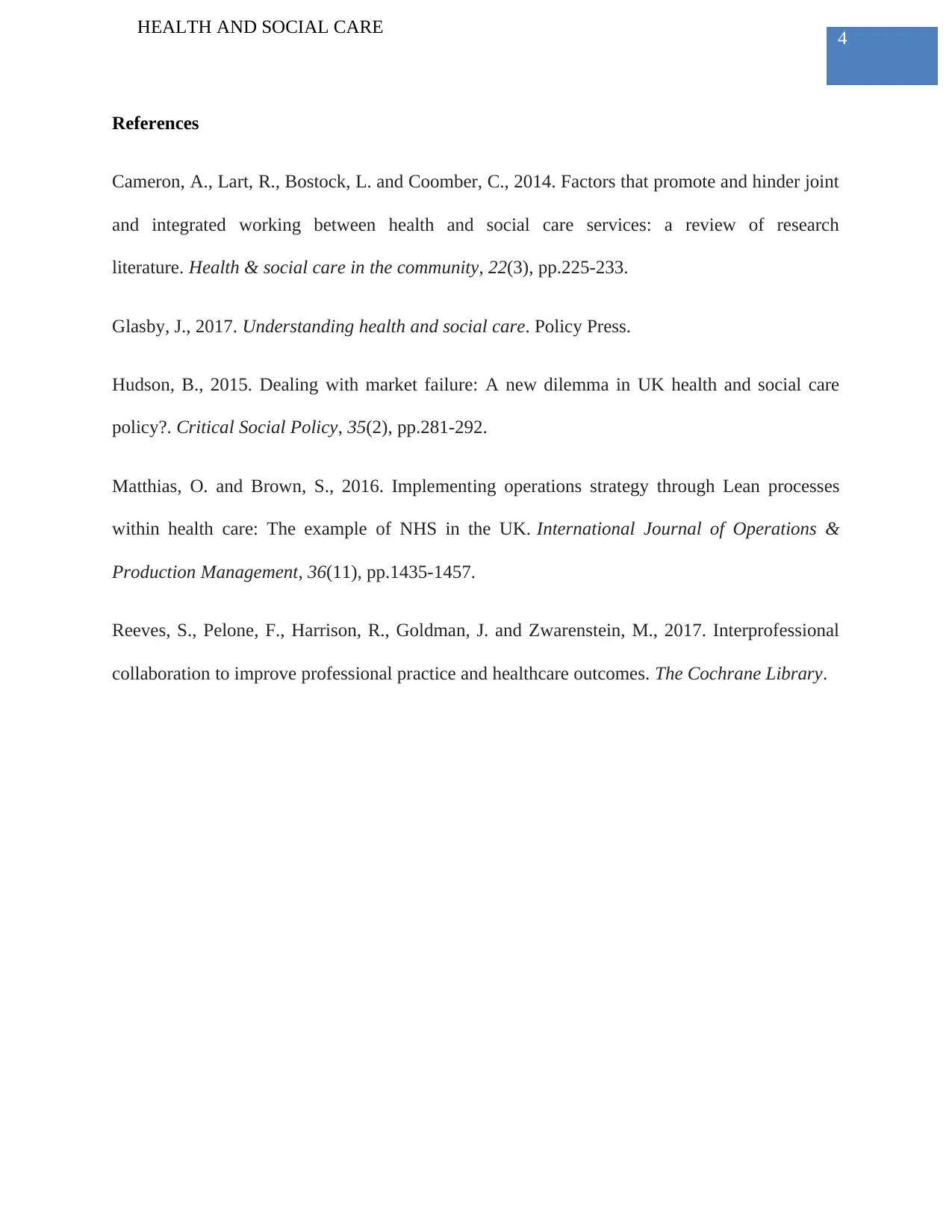
4
HEALTH AND SOCIAL CARE
References
Cameron, A., Lart, R., Bostock, L. and Coomber, C., 2014. Factors that promote and hinder joint
and integrated working between health and social care services: a review of research
literature. Health & social care in the community, 22(3), pp.225-233.
Glasby, J., 2017. Understanding health and social care. Policy Press.
Hudson, B., 2015. Dealing with market failure: A new dilemma in UK health and social care
policy?. Critical Social Policy, 35(2), pp.281-292.
Matthias, O. and Brown, S., 2016. Implementing operations strategy through Lean processes
within health care: The example of NHS in the UK. International Journal of Operations &
Production Management, 36(11), pp.1435-1457.
Reeves, S., Pelone, F., Harrison, R., Goldman, J. and Zwarenstein, M., 2017. Interprofessional
collaboration to improve professional practice and healthcare outcomes. The Cochrane Library.
HEALTH AND SOCIAL CARE
References
Cameron, A., Lart, R., Bostock, L. and Coomber, C., 2014. Factors that promote and hinder joint
and integrated working between health and social care services: a review of research
literature. Health & social care in the community, 22(3), pp.225-233.
Glasby, J., 2017. Understanding health and social care. Policy Press.
Hudson, B., 2015. Dealing with market failure: A new dilemma in UK health and social care
policy?. Critical Social Policy, 35(2), pp.281-292.
Matthias, O. and Brown, S., 2016. Implementing operations strategy through Lean processes
within health care: The example of NHS in the UK. International Journal of Operations &
Production Management, 36(11), pp.1435-1457.
Reeves, S., Pelone, F., Harrison, R., Goldman, J. and Zwarenstein, M., 2017. Interprofessional
collaboration to improve professional practice and healthcare outcomes. The Cochrane Library.
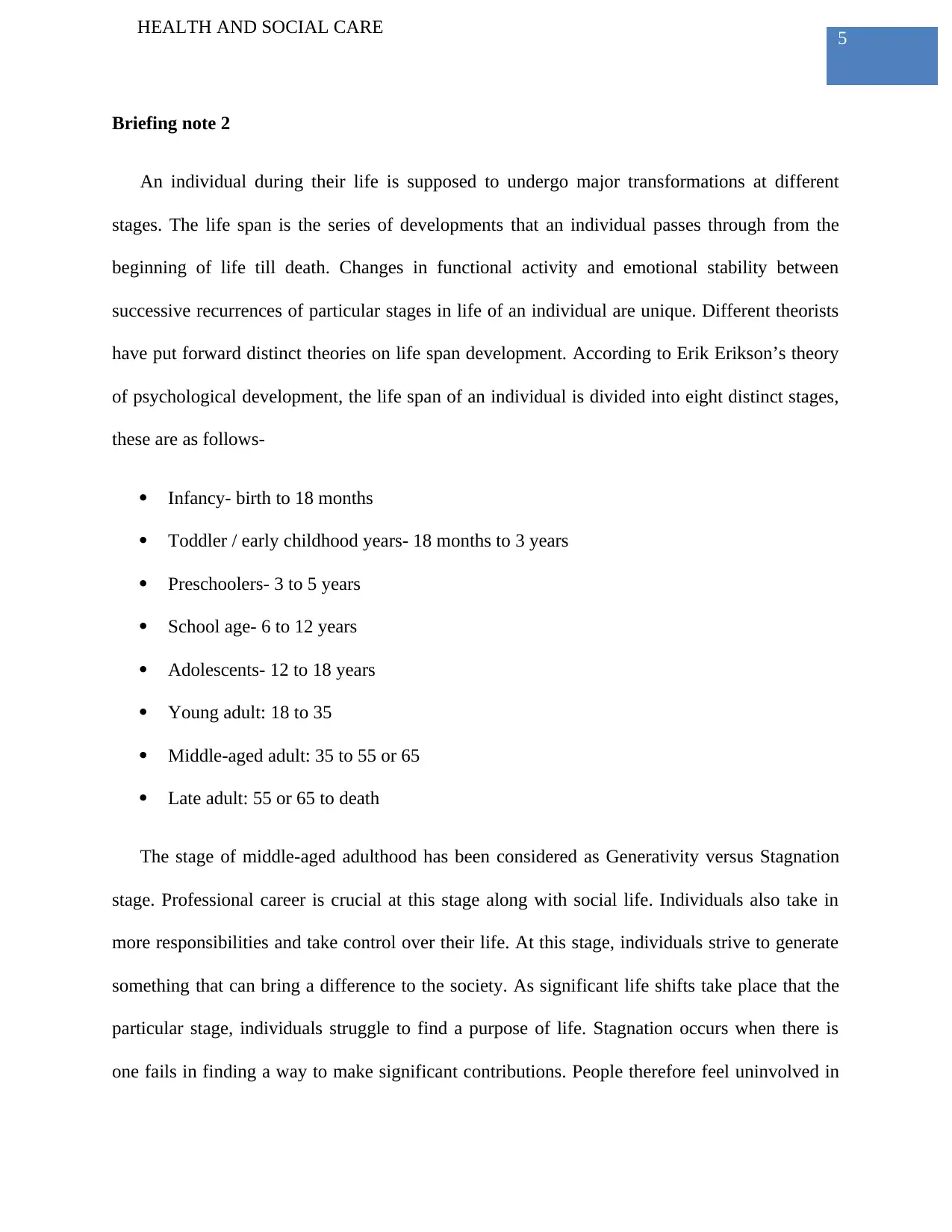
5
HEALTH AND SOCIAL CARE
Briefing note 2
An individual during their life is supposed to undergo major transformations at different
stages. The life span is the series of developments that an individual passes through from the
beginning of life till death. Changes in functional activity and emotional stability between
successive recurrences of particular stages in life of an individual are unique. Different theorists
have put forward distinct theories on life span development. According to Erik Erikson’s theory
of psychological development, the life span of an individual is divided into eight distinct stages,
these are as follows-
Infancy- birth to 18 months
Toddler / early childhood years- 18 months to 3 years
Preschoolers- 3 to 5 years
School age- 6 to 12 years
Adolescents- 12 to 18 years
Young adult: 18 to 35
Middle-aged adult: 35 to 55 or 65
Late adult: 55 or 65 to death
The stage of middle-aged adulthood has been considered as Generativity versus Stagnation
stage. Professional career is crucial at this stage along with social life. Individuals also take in
more responsibilities and take control over their life. At this stage, individuals strive to generate
something that can bring a difference to the society. As significant life shifts take place that the
particular stage, individuals struggle to find a purpose of life. Stagnation occurs when there is
one fails in finding a way to make significant contributions. People therefore feel uninvolved in
HEALTH AND SOCIAL CARE
Briefing note 2
An individual during their life is supposed to undergo major transformations at different
stages. The life span is the series of developments that an individual passes through from the
beginning of life till death. Changes in functional activity and emotional stability between
successive recurrences of particular stages in life of an individual are unique. Different theorists
have put forward distinct theories on life span development. According to Erik Erikson’s theory
of psychological development, the life span of an individual is divided into eight distinct stages,
these are as follows-
Infancy- birth to 18 months
Toddler / early childhood years- 18 months to 3 years
Preschoolers- 3 to 5 years
School age- 6 to 12 years
Adolescents- 12 to 18 years
Young adult: 18 to 35
Middle-aged adult: 35 to 55 or 65
Late adult: 55 or 65 to death
The stage of middle-aged adulthood has been considered as Generativity versus Stagnation
stage. Professional career is crucial at this stage along with social life. Individuals also take in
more responsibilities and take control over their life. At this stage, individuals strive to generate
something that can bring a difference to the society. As significant life shifts take place that the
particular stage, individuals struggle to find a purpose of life. Stagnation occurs when there is
one fails in finding a way to make significant contributions. People therefore feel uninvolved in
⊘ This is a preview!⊘
Do you want full access?
Subscribe today to unlock all pages.

Trusted by 1+ million students worldwide
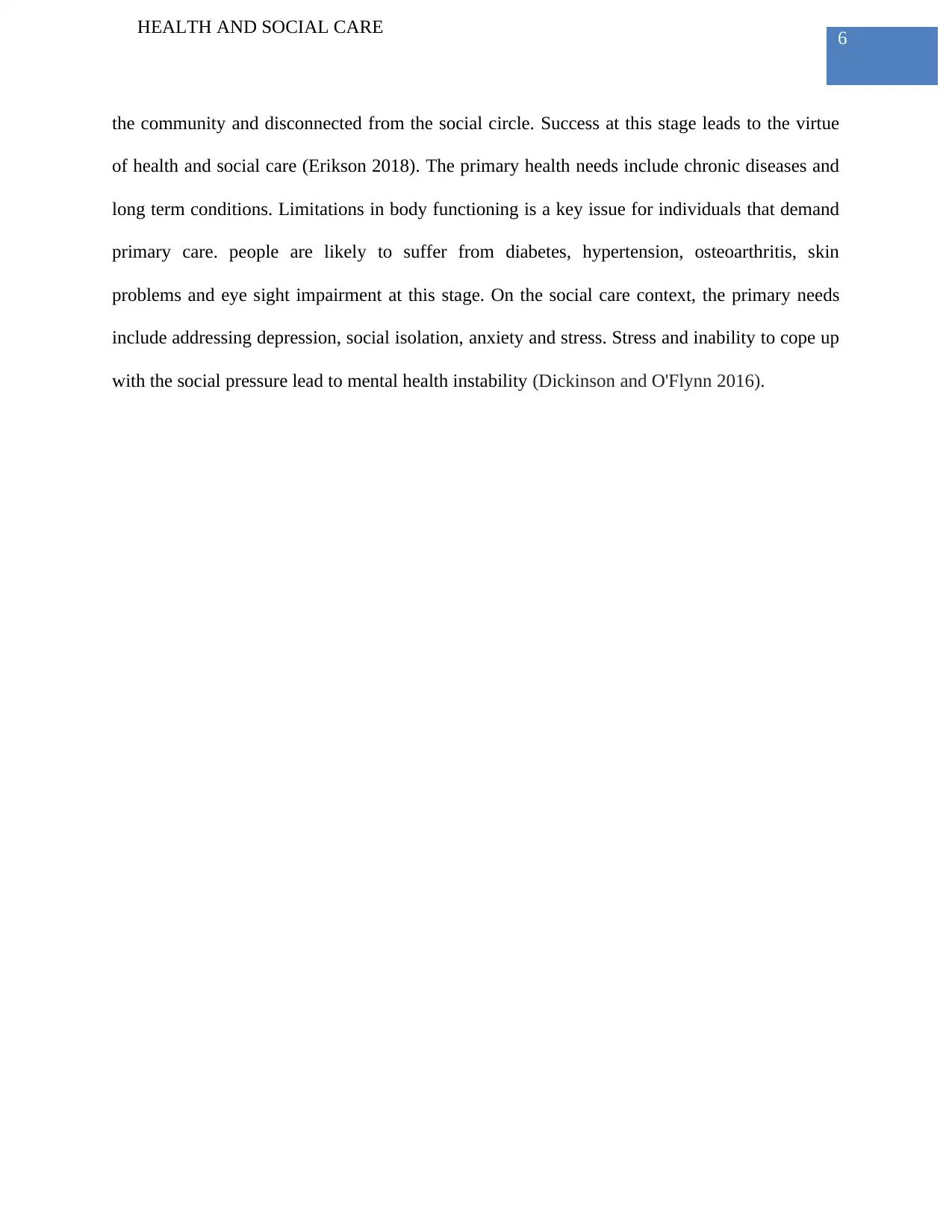
6
HEALTH AND SOCIAL CARE
the community and disconnected from the social circle. Success at this stage leads to the virtue
of health and social care (Erikson 2018). The primary health needs include chronic diseases and
long term conditions. Limitations in body functioning is a key issue for individuals that demand
primary care. people are likely to suffer from diabetes, hypertension, osteoarthritis, skin
problems and eye sight impairment at this stage. On the social care context, the primary needs
include addressing depression, social isolation, anxiety and stress. Stress and inability to cope up
with the social pressure lead to mental health instability (Dickinson and O'Flynn 2016).
HEALTH AND SOCIAL CARE
the community and disconnected from the social circle. Success at this stage leads to the virtue
of health and social care (Erikson 2018). The primary health needs include chronic diseases and
long term conditions. Limitations in body functioning is a key issue for individuals that demand
primary care. people are likely to suffer from diabetes, hypertension, osteoarthritis, skin
problems and eye sight impairment at this stage. On the social care context, the primary needs
include addressing depression, social isolation, anxiety and stress. Stress and inability to cope up
with the social pressure lead to mental health instability (Dickinson and O'Flynn 2016).
Paraphrase This Document
Need a fresh take? Get an instant paraphrase of this document with our AI Paraphraser
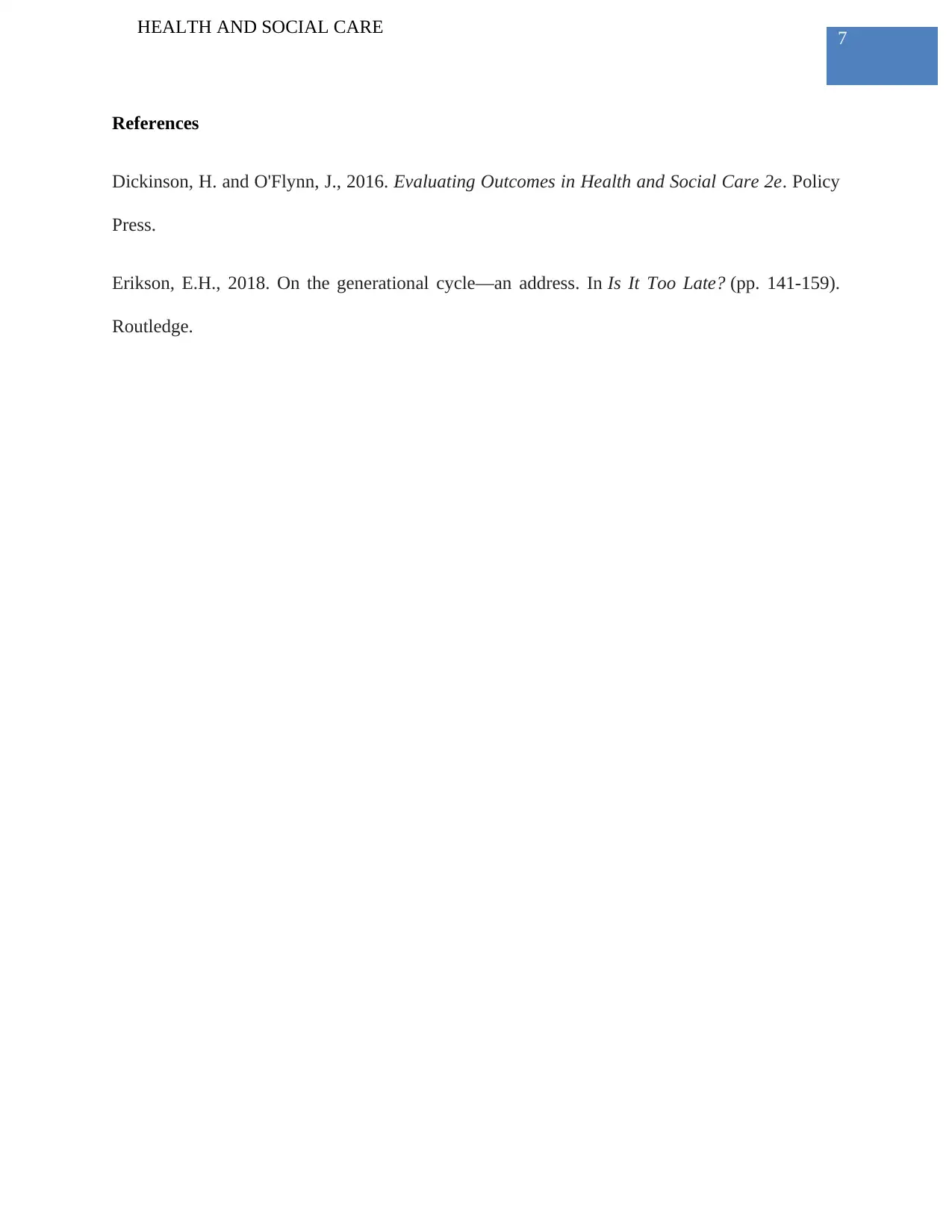
7
HEALTH AND SOCIAL CARE
References
Dickinson, H. and O'Flynn, J., 2016. Evaluating Outcomes in Health and Social Care 2e. Policy
Press.
Erikson, E.H., 2018. On the generational cycle—an address. In Is It Too Late? (pp. 141-159).
Routledge.
HEALTH AND SOCIAL CARE
References
Dickinson, H. and O'Flynn, J., 2016. Evaluating Outcomes in Health and Social Care 2e. Policy
Press.
Erikson, E.H., 2018. On the generational cycle—an address. In Is It Too Late? (pp. 141-159).
Routledge.
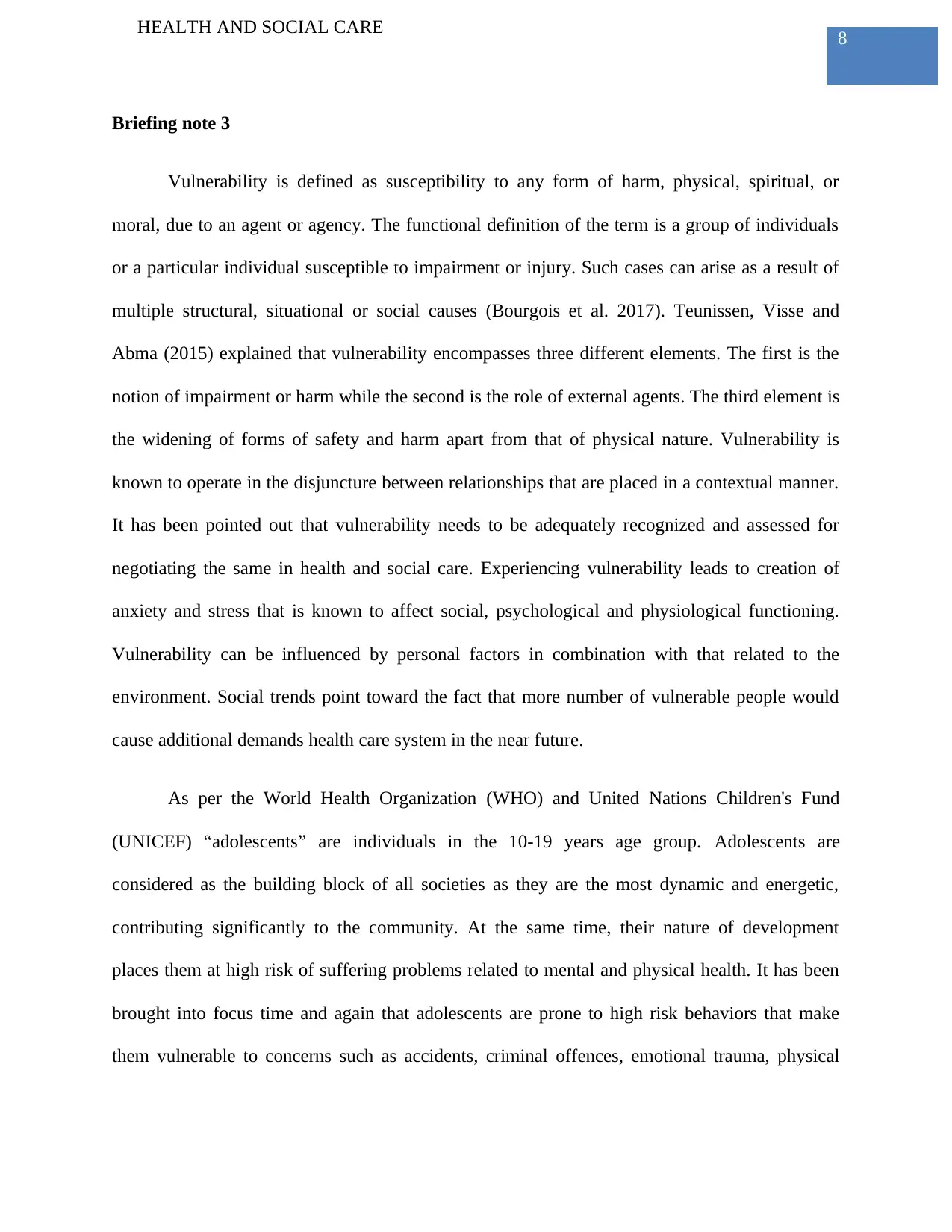
8
HEALTH AND SOCIAL CARE
Briefing note 3
Vulnerability is defined as susceptibility to any form of harm, physical, spiritual, or
moral, due to an agent or agency. The functional definition of the term is a group of individuals
or a particular individual susceptible to impairment or injury. Such cases can arise as a result of
multiple structural, situational or social causes (Bourgois et al. 2017). Teunissen, Visse and
Abma (2015) explained that vulnerability encompasses three different elements. The first is the
notion of impairment or harm while the second is the role of external agents. The third element is
the widening of forms of safety and harm apart from that of physical nature. Vulnerability is
known to operate in the disjuncture between relationships that are placed in a contextual manner.
It has been pointed out that vulnerability needs to be adequately recognized and assessed for
negotiating the same in health and social care. Experiencing vulnerability leads to creation of
anxiety and stress that is known to affect social, psychological and physiological functioning.
Vulnerability can be influenced by personal factors in combination with that related to the
environment. Social trends point toward the fact that more number of vulnerable people would
cause additional demands health care system in the near future.
As per the World Health Organization (WHO) and United Nations Children's Fund
(UNICEF) “adolescents” are individuals in the 10-19 years age group. Adolescents are
considered as the building block of all societies as they are the most dynamic and energetic,
contributing significantly to the community. At the same time, their nature of development
places them at high risk of suffering problems related to mental and physical health. It has been
brought into focus time and again that adolescents are prone to high risk behaviors that make
them vulnerable to concerns such as accidents, criminal offences, emotional trauma, physical
HEALTH AND SOCIAL CARE
Briefing note 3
Vulnerability is defined as susceptibility to any form of harm, physical, spiritual, or
moral, due to an agent or agency. The functional definition of the term is a group of individuals
or a particular individual susceptible to impairment or injury. Such cases can arise as a result of
multiple structural, situational or social causes (Bourgois et al. 2017). Teunissen, Visse and
Abma (2015) explained that vulnerability encompasses three different elements. The first is the
notion of impairment or harm while the second is the role of external agents. The third element is
the widening of forms of safety and harm apart from that of physical nature. Vulnerability is
known to operate in the disjuncture between relationships that are placed in a contextual manner.
It has been pointed out that vulnerability needs to be adequately recognized and assessed for
negotiating the same in health and social care. Experiencing vulnerability leads to creation of
anxiety and stress that is known to affect social, psychological and physiological functioning.
Vulnerability can be influenced by personal factors in combination with that related to the
environment. Social trends point toward the fact that more number of vulnerable people would
cause additional demands health care system in the near future.
As per the World Health Organization (WHO) and United Nations Children's Fund
(UNICEF) “adolescents” are individuals in the 10-19 years age group. Adolescents are
considered as the building block of all societies as they are the most dynamic and energetic,
contributing significantly to the community. At the same time, their nature of development
places them at high risk of suffering problems related to mental and physical health. It has been
brought into focus time and again that adolescents are prone to high risk behaviors that make
them vulnerable to concerns such as accidents, criminal offences, emotional trauma, physical
⊘ This is a preview!⊘
Do you want full access?
Subscribe today to unlock all pages.

Trusted by 1+ million students worldwide
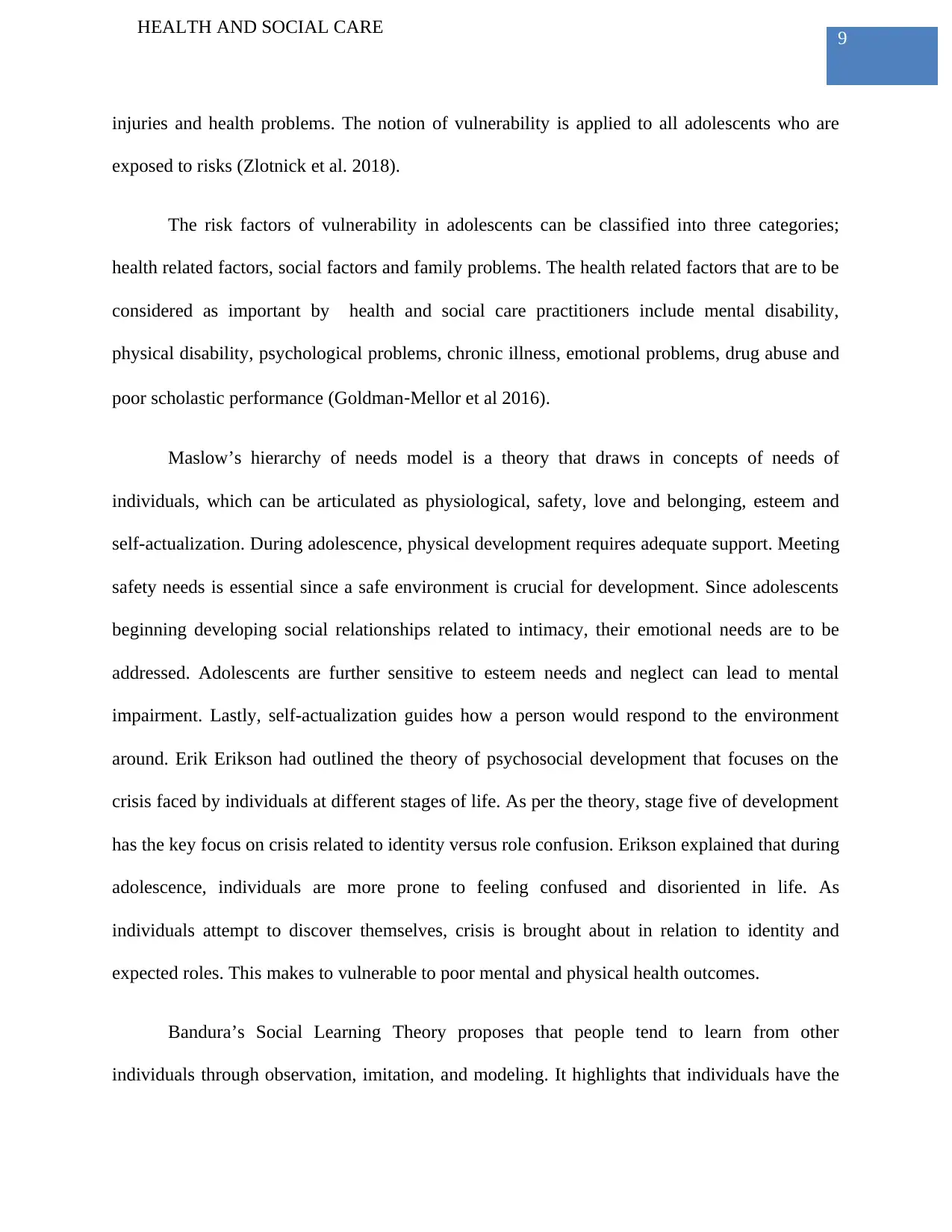
9
HEALTH AND SOCIAL CARE
injuries and health problems. The notion of vulnerability is applied to all adolescents who are
exposed to risks (Zlotnick et al. 2018).
The risk factors of vulnerability in adolescents can be classified into three categories;
health related factors, social factors and family problems. The health related factors that are to be
considered as important by health and social care practitioners include mental disability,
physical disability, psychological problems, chronic illness, emotional problems, drug abuse and
poor scholastic performance (Goldman‐Mellor et al 2016).
Maslow’s hierarchy of needs model is a theory that draws in concepts of needs of
individuals, which can be articulated as physiological, safety, love and belonging, esteem and
self-actualization. During adolescence, physical development requires adequate support. Meeting
safety needs is essential since a safe environment is crucial for development. Since adolescents
beginning developing social relationships related to intimacy, their emotional needs are to be
addressed. Adolescents are further sensitive to esteem needs and neglect can lead to mental
impairment. Lastly, self-actualization guides how a person would respond to the environment
around. Erik Erikson had outlined the theory of psychosocial development that focuses on the
crisis faced by individuals at different stages of life. As per the theory, stage five of development
has the key focus on crisis related to identity versus role confusion. Erikson explained that during
adolescence, individuals are more prone to feeling confused and disoriented in life. As
individuals attempt to discover themselves, crisis is brought about in relation to identity and
expected roles. This makes to vulnerable to poor mental and physical health outcomes.
Bandura’s Social Learning Theory proposes that people tend to learn from other
individuals through observation, imitation, and modeling. It highlights that individuals have the
HEALTH AND SOCIAL CARE
injuries and health problems. The notion of vulnerability is applied to all adolescents who are
exposed to risks (Zlotnick et al. 2018).
The risk factors of vulnerability in adolescents can be classified into three categories;
health related factors, social factors and family problems. The health related factors that are to be
considered as important by health and social care practitioners include mental disability,
physical disability, psychological problems, chronic illness, emotional problems, drug abuse and
poor scholastic performance (Goldman‐Mellor et al 2016).
Maslow’s hierarchy of needs model is a theory that draws in concepts of needs of
individuals, which can be articulated as physiological, safety, love and belonging, esteem and
self-actualization. During adolescence, physical development requires adequate support. Meeting
safety needs is essential since a safe environment is crucial for development. Since adolescents
beginning developing social relationships related to intimacy, their emotional needs are to be
addressed. Adolescents are further sensitive to esteem needs and neglect can lead to mental
impairment. Lastly, self-actualization guides how a person would respond to the environment
around. Erik Erikson had outlined the theory of psychosocial development that focuses on the
crisis faced by individuals at different stages of life. As per the theory, stage five of development
has the key focus on crisis related to identity versus role confusion. Erikson explained that during
adolescence, individuals are more prone to feeling confused and disoriented in life. As
individuals attempt to discover themselves, crisis is brought about in relation to identity and
expected roles. This makes to vulnerable to poor mental and physical health outcomes.
Bandura’s Social Learning Theory proposes that people tend to learn from other
individuals through observation, imitation, and modeling. It highlights that individuals have the
Paraphrase This Document
Need a fresh take? Get an instant paraphrase of this document with our AI Paraphraser
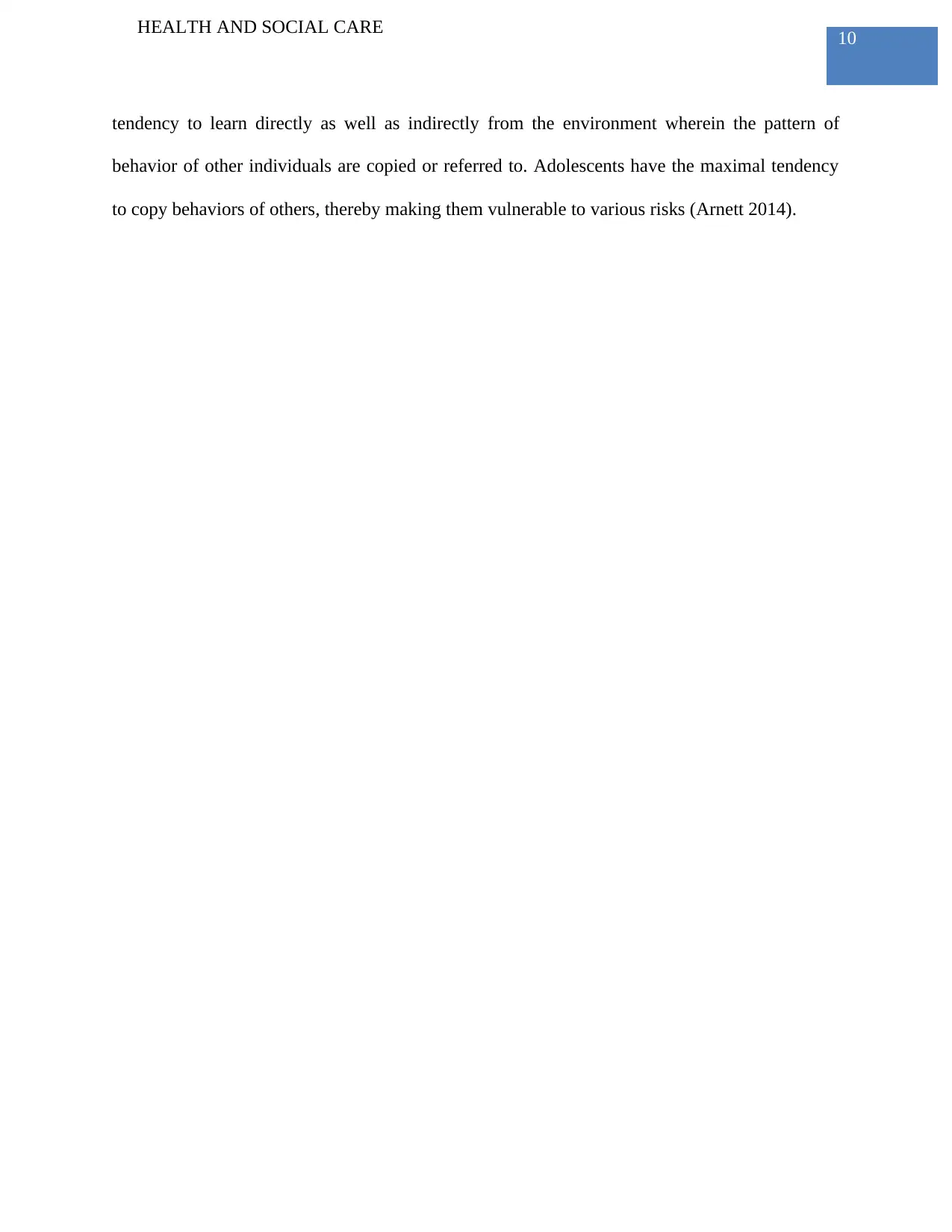
10
HEALTH AND SOCIAL CARE
tendency to learn directly as well as indirectly from the environment wherein the pattern of
behavior of other individuals are copied or referred to. Adolescents have the maximal tendency
to copy behaviors of others, thereby making them vulnerable to various risks (Arnett 2014).
HEALTH AND SOCIAL CARE
tendency to learn directly as well as indirectly from the environment wherein the pattern of
behavior of other individuals are copied or referred to. Adolescents have the maximal tendency
to copy behaviors of others, thereby making them vulnerable to various risks (Arnett 2014).
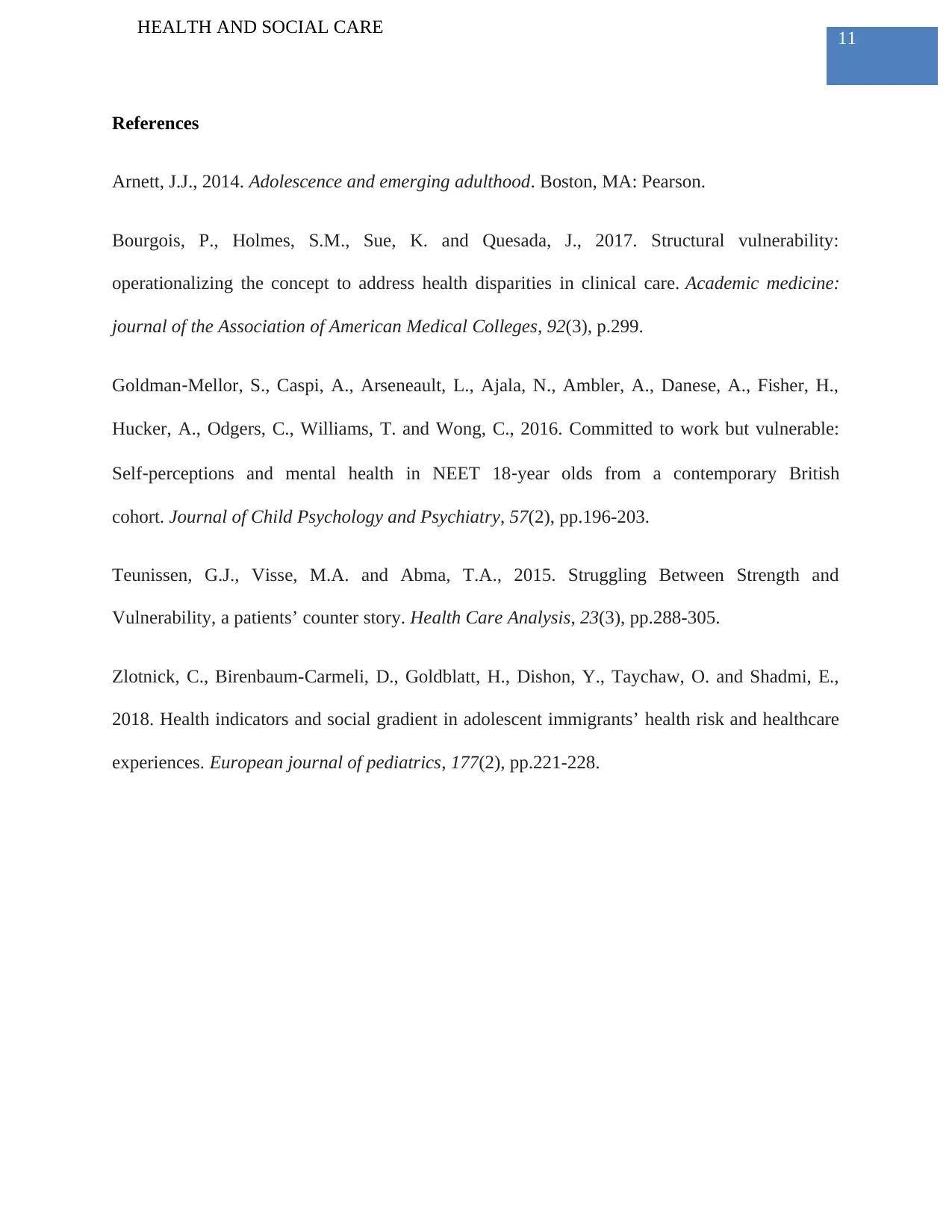
11
HEALTH AND SOCIAL CARE
References
Arnett, J.J., 2014. Adolescence and emerging adulthood. Boston, MA: Pearson.
Bourgois, P., Holmes, S.M., Sue, K. and Quesada, J., 2017. Structural vulnerability:
operationalizing the concept to address health disparities in clinical care. Academic medicine:
journal of the Association of American Medical Colleges, 92(3), p.299.
Goldman‐Mellor, S., Caspi, A., Arseneault, L., Ajala, N., Ambler, A., Danese, A., Fisher, H.,
Hucker, A., Odgers, C., Williams, T. and Wong, C., 2016. Committed to work but vulnerable:
Self‐perceptions and mental health in NEET 18‐year olds from a contemporary British
cohort. Journal of Child Psychology and Psychiatry, 57(2), pp.196-203.
Teunissen, G.J., Visse, M.A. and Abma, T.A., 2015. Struggling Between Strength and
Vulnerability, a patients’ counter story. Health Care Analysis, 23(3), pp.288-305.
Zlotnick, C., Birenbaum-Carmeli, D., Goldblatt, H., Dishon, Y., Taychaw, O. and Shadmi, E.,
2018. Health indicators and social gradient in adolescent immigrants’ health risk and healthcare
experiences. European journal of pediatrics, 177(2), pp.221-228.
HEALTH AND SOCIAL CARE
References
Arnett, J.J., 2014. Adolescence and emerging adulthood. Boston, MA: Pearson.
Bourgois, P., Holmes, S.M., Sue, K. and Quesada, J., 2017. Structural vulnerability:
operationalizing the concept to address health disparities in clinical care. Academic medicine:
journal of the Association of American Medical Colleges, 92(3), p.299.
Goldman‐Mellor, S., Caspi, A., Arseneault, L., Ajala, N., Ambler, A., Danese, A., Fisher, H.,
Hucker, A., Odgers, C., Williams, T. and Wong, C., 2016. Committed to work but vulnerable:
Self‐perceptions and mental health in NEET 18‐year olds from a contemporary British
cohort. Journal of Child Psychology and Psychiatry, 57(2), pp.196-203.
Teunissen, G.J., Visse, M.A. and Abma, T.A., 2015. Struggling Between Strength and
Vulnerability, a patients’ counter story. Health Care Analysis, 23(3), pp.288-305.
Zlotnick, C., Birenbaum-Carmeli, D., Goldblatt, H., Dishon, Y., Taychaw, O. and Shadmi, E.,
2018. Health indicators and social gradient in adolescent immigrants’ health risk and healthcare
experiences. European journal of pediatrics, 177(2), pp.221-228.
⊘ This is a preview!⊘
Do you want full access?
Subscribe today to unlock all pages.

Trusted by 1+ million students worldwide
1 out of 12
Related Documents
Your All-in-One AI-Powered Toolkit for Academic Success.
+13062052269
info@desklib.com
Available 24*7 on WhatsApp / Email
![[object Object]](/_next/static/media/star-bottom.7253800d.svg)
Unlock your academic potential
Copyright © 2020–2025 A2Z Services. All Rights Reserved. Developed and managed by ZUCOL.





